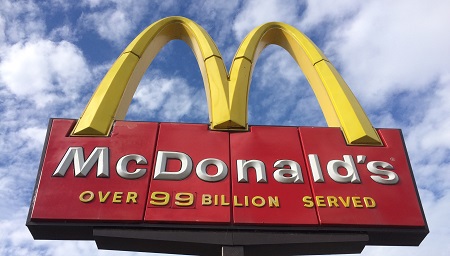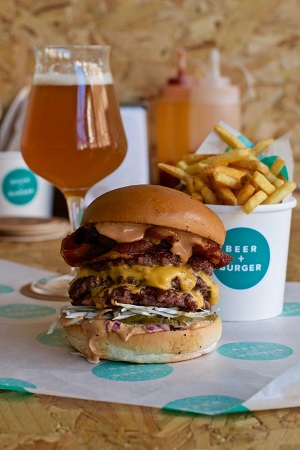The colourful history of the humble burger began, as these stories often do, with the ancient Romans. They loved to eat what we now call “street food”, and one example of the delicacies enjoyed by Romans and their subjects – along with peacock tongues and baked dormice – was Isicia Omentata, which translates roughly as “stuffed minced meat”. A recipe book dating from around 1,500 years ago – towards the end of the Roman empire – includes a recipe for this dish, which today would be instantly recognisable as a kind of burger: minced meat (they used pork rather than beef), pine kernels, fish sauce, juniper berries, coriander and ground pepper, mixed together to form a patty, and then fried.
Fast-forward to the 18th century, when Hamburg was the centre of a thriving trading network. It was also famous for one food item in particular: the Hamburg steak, known locally as the frikadelle or bulette.
This was made from minced or ground beef, with spices and onions added, made into a patty and then cooked on a grill or a flame, or sometimes served raw. Here, then, lie the origins of what eventually became known as the hamburger, the simple patty of ground beef flavoured with onion and spices, and bound with egg and milk, that is now consumed by billions worldwide.
Raising the steaks
So how did the Hamburg steak make its way from Germany to what is now known as the home of the hamburger – the USA? In the 19th century, migrants and sailors from Hamburg and along the Baltic coast of Germany made their way to New York, where they were given a taste of the home country by food outlets selling Hamburg steaks – the oldest document referring to it is a menu from a New York restaurant, Delmonico’s, in 1873. But still, it was served on its own; there was no mention of bread or buns. Meanwhile in Britain, Victorians were eating something called minced collops, which closely resembled the hamburger.
Food to relish
There are several different stories telling how the Hamburg steak came to be placed between two pieces of bread, or toast, or in a bun. But what is certain is that between 1885 and 1900, the habit of eating burgers this way caught on in several US cities. Today it seems like a perfectly natural thing to do; what’s remarkable is that it took so long for it to catch on.
By the early years of the 20th century, the Hamburg steak had become known as the hamburger (and, later, simply the burger): a patty of grilled beef and other ingredients, served in a bun. As time went on, other ingredients were added, notably cheese, as well as pickles and relishes. In 1921 a US chain of restaurants was born: White Castle – the world’s first hamburger chain. At the time, many Americans saw hamburgers as unsafe, a lower form of food, so White Castle ensured that its restaurants, and staff, were spotlessly clean. White Castle still trades today, with nearly 400 branches across the US.

Other chains followed, notably McDonald’s, which started business in California in 1940. Meanwhile Wimpy bars brought the hamburger to a hungry UK in the 1950s. The first McDonald’s restaurant opened in the UK in 1974, located in Woolwich in south-east London. There was some resistance to the growth in the UK of McDonald’s: local campaigners in upmarket Hampstead, north London, campaigned against the opening of a branch on the high street. When it eventually opened in 1993, it had tasteful frontage and décor to fit in with the surroundings.
The burger backlash
The burger had become a staple part of British culinary and cultural life. But it had also become associated with low-quality fast food: a soggy bun, a thin burger, served in functional surroundings which, legend had it, were sometimes uncomfortable enough to encourage diners not to linger. “Burger flipping” jobs became synonymous with the worst aspects of the service economy, and burgers themselves were in the spotlight for their alleged contribution to planetary degradation, as well as the obesity crisis. Morgan Spurlock’s 2004 documentary Super Size Me saw Spurlock’s health deteriorate as he followed a purely fast-food diet, taking restaurants up on their offers to “super size” his orders. Branches of McDonald’s have been targeted in France and other European cities by anti-globalisation and anti-American protestors.
.jpg)
Born-again burger
But in 2001 the British burger began its rehabilitation. Gourmet Burger Kitchen, set up by three New Zealanders, started serving quality burgers made from high-quality meat and “global” ingredients such as pineapple and kiwi fruit. A few years later the Byron chain took the burger back to basics, serving simple but high-quality burgers and other dishes in attractive surroundings. Others that followed included Five Guys, Shake Shack, and Beer + Burger.

Going out for a burger has now become a destination, an event, rather than a quick and easy way of getting some food and drink. Chips these days are fat and crispy. Proper ketchup and mayonnaise are served from bottles at the table. Brioche buns have become widely used. These restaurants boast of the quality of the beef and other meats used in their burgers. The veggie burger has grown in popularity, as has the vegan burger. These days, the veggie or vegan burger is appetising and substantial enough to be an option chosen by many meat-eaters. Some vegetarian burgers try to emulate the texture of meat, even down to including beetroot juice to replicate the blood of a rare burger.
The surroundings, décor and furniture in these restaurants are likewise a huge improvement on their mass-market counterparts: this is not exactly fine dining, but the chairs, banquettes, benches and tables are solid, tasteful and comfortable. In some instances, such as Ed’s Diner and Five Guys, the retro fittings, tiled walls, chequered floors, cosy booths and benches and red-and-white colour schemes hark back to the glory days of the American diner.
The old man and the burger
So the burger has journeyed from Europe to America and back, and has undergone a transformation from junk food to proper fare. Today’s diners have a wealth of choice, and can eat their burgers (with their hands, or using a knife and fork? Always a dilemma!) in stylish surroundings.
Curiously, none of the new higher-end burger restaurants have seen fit to revive a hamburger recipe written by the great American novelist Ernest Hemingway. It was found among thousands of his papers years after he died, and is typically extravagant, using capers, wine and spicy sauces.
And finally, among some historians and political scientists, the burger is associated with something of far greater importance than its nutritional value: peace. The “golden arch theory” of history says that there is no example in the history of the world of two countries with branches of McDonald’s going to war with each other. So, for all its negative associations, the humble hamburger might have been a force for good in the world.
Enjoyed this blog? Why not read more? Discover the history of bread and the origin of breakfast, just a selection of the great articles available in the Trent Furniture blog.